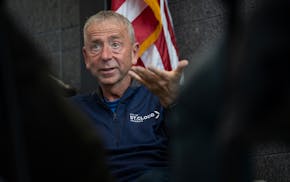George Floyd's tragic death under the knee of a Minneapolis police officer, captured on video for the world to see, moved millions. It opened eyes, touched hearts and minds, and catapulted America into demanding changes in policing and a national reckoning on race.
So it's fitting that a permanent memorial — a place for public mourning, prayer, healing and learning — should be on or near the place where Floyd died. That's what the site has become organically, as people locally and around the country have used it as a place of reflection.
City officials had planned to reopen the intersection at 38th Street and Chicago Avenue on Aug. 17 but wisely postponed that move to hold more discussions with community members on the fate of the site.
The current makeshift memorial features a large sculpture of a raised fist. The site has been filled with artwork, flowers and heartfelt written material honoring Floyd and other Black people killed by police.
City staffers attended dozens of community events to gather input about the future of the intersection, collecting a wide range of ideas. Some want a space to promote racial justice and healing, while others believe it should be a place for mourning and public art. Still others think that homeownership opportunities in the area should be expanded.
Other options mentioned include reopening 38th Street but keeping Chicago closed, preserving the roundabout, creating a place for a garden and sculptures near the intersection, and turning the site into a pedestrian-only area.
One certainty is that the site must provide access for first responders to get to nearby homes and businesses quickly in case of an emergency. The final plan for a memorial should balance the need for a place of reflection with the practicalities of moving traffic and supporting businesses.
And any memorial should include a representation of the iconic mural of Floyd that was painted by local artists just a few days after his death as an expression of the pain the community was feeling. It is important to preserve the mural not only in memory of Floyd, but of the many other Black and brown people who have died in America at the hands of police.
Floyd's face is at the center of the beautiful work of art, under a heading that says "say our names" — a take on an expression that has become a motto of Black Lives Matter and of the professional athletes who have stood for that cause this season. The mural's background lists of dozens of others who have lost their lives during encounters with police.
In another effort to promote healing, when it meets in the September the City Council should approve the proposal to give Chicago Avenue between 37th and 39th streets the commemorative name of "George Perry Floyd Jr. Place."
Council Vice President Andrea Jenkins and member Alondra Cano, whose wards meet at 38th and Chicago, want to create a commission to focus on what should be done at the site and set up public hearings. The city has allocated $100,000 for the community engagement process, and the city is seeking financing from the state and federal government, nonprofits and others to finance a memorial.
"I want to highlight the national and international importance of this intersection not only in Minneapolis but around the world," Jenkins told an editorial writer. "A memorial should inspire and motivate people to pursue racial justice."
That's a goal all Minnesotans should embrace.

Kudos to St. Cloud's longtime mayor
Readers Write: Ethnic studies curriculum, public notice laws, student protests


